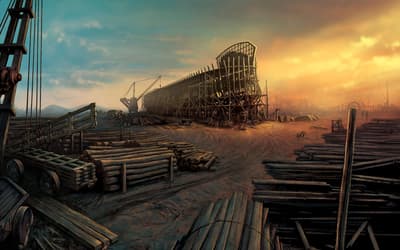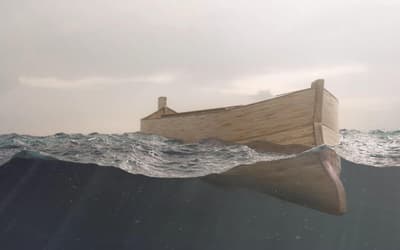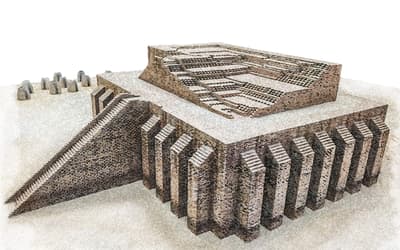The views expressed in this paper are those of the writer(s) and are not necessarily those of the ARJ Editor or Answers in Genesis.
Abstract
The movements of early man, as narrated in the Bible, can be related to modern geography only if we correctly determine the people, places, and chronology involved. But archaeological research alone is not enough to accomplish this. Other disciplines such as history, linguistics, geology, geography, and chronology must also be given their due. We show here that Babel was in North Mesopotamia, Shinar was not Sumer, Sumer was not Semitic, Abraham’s Urkasdim was in North Mesopotamia, biblical Elam/Elamu/Elamtu was in North Syria and was not Susiana, and the Ubaid people lived after the end of the Ice Age, long after the Babel dispersion. All structures in South Mesopotamia are built on the alluvium deposited by run-off of the Ice Age meltdown flooding; this territory was under water when the oceans settled earlier at the end of Noah’s Flood, and Babel could not have been built there. This all has implications for the migration of the sons of Shem, who could not have migrated to South Mesopotamia, as claimed by Osgood.
Keywords: Babel, Elam, Ice Age, Shinar, Sumer, Susiana, Ubaid, Ur, Uruk, Nimrod
Introduction
Although archaeology is important in determining much that happened in history, it is not the only discipline that needs to be applied. We show in this reply that the scenario proposed by Osgood in his paper (Osgood 2023) for the migration of the sons of Shem is not possible from the point of view of geology, history, archaeology, geography, linguistics and chronology. These disciplines all come into the arguments in various ways, as we will show.
Discussion
Osgood ends his paper by mentioning that Babel was probably in Lower Mesopotamia. This is not a possible location for Babel, because at the time that they were building the Tower, geology shows that the southern half of Iraq was under water. Babel was in North Mesopotamia. Extensive arguments on this subject are made in my paper, “Where in the World is the Tower of Babel?” (Habermehl 2011), including that Babel and Babylon were two different names for two different locations. This is one place where geology roars, and overrides all other arguments incorrectly made for putting the Tower in South Mesopotamia. Those who would claim that this is merely a theory are overlooking solid science to do so. Only structures built after the Ice Age meltdown are located in South Mesopotamia on top of the alluvium; the Babel dispersion occurred long before that.
We also point out that Sumer in South Mesopotamia is not Shinar. See Habermehl (2011) for a discussion and references on this subject. The flawed belief that Sumer and Shinar are the same place is part of the issue of where Babel is, and it is those who believe that Babel is in South Mesopotamia who try to make Sumer and Shinar mean the same thing. Since Shinar was in the north of Mesopotamia, and Sumer was in the south, they are clearly two different places. The meaning of Shinar is from the Semitic “two rivers” (Smith 1948, 622), while Sumer is claimed to mean “land of the civilized kings” (Mark 2011). Neither of these has the meaning of “Shem” or “Semitic” in it. In addition, the language of Sumer is considered an isolate, and is not related to any other language, Semitic or otherwise (Sumer 2023). The claim that Shinar and Sumer are related is seriously flawed. All archaeology of Sumer is post Ice Age, long after Babel in the north, and has nothing to do with the migration of the sons of Shem.
The flood levels at Ur were not caused by the rising of the waters after the melting of the ice, as claimed by Oppenheimer (1998). Those levels of flooding were from meltwater that washed sediments down from the Turkish mountains in the north and the Zagros Mountains to the east (see the section of the geology of south Mesopotamia in Habermehl 2011). The rising ocean waters never reached Ur. As a point of correction, Woolley’s Ur(im) was not under water at the end of the Ice Age from rising ocean waters when the Persian Gulf’s water level rose to 2½ m higher than today (Ur 2023). The ruins of Ur lie 18 m above ocean level (Elevation of Ancient Ruins of Ur 2023 ), so that when Ur was founded it was about 15½ m above water after the Ice meltdown. As a reference on this, Oppenheimer was a pediatrician and evolutionist who presents Eden as being in Sundaland. Oppenheimer’s geology and geography are shaky, to say the least, and this reference is not viable for a YEC paper. For more on this, see discussion on Abraham’s Urkasdim further on in this article.
Osgood’s characterization of the use of the LXX to get more time in order to synchronize with the Egyptian timeline shows that he does not understand either the LXX or the Egyptian timeline. It is true that the LXX offers more time by a few hundred years than the MT between the Flood and Babel. But the Egyptian/secular timeline does not have the Flood anywhere on it, and for good reason. As I show in my Gobekli Tepe paper comparing the secular and LXX timelines (Habermehl 2018), Babel has to have been more than 1.76 million secular years ago. The Flood is incredibly farther back in time before that because of the extreme stretching out of the secular timeline. As a revisionist of the Egyptian timeline myself (see Habermehl 2013, 2023), there is no way that I am influenced by that timeline in my support for the LXX. There is good work that has been published on the LXX and the claims for it (for example, Smith 2018).
Furthermore, Osgood makes a serious mathematical error in his claim that there would be millions of people at Babel, if the LXX is followed. He has missed the fact that there are the same number of generations between the Flood and Babel in both the LXX and MT, and that therefore there would be the same number of people either way. It is merely that there are more years per generation in the LXX than the MT; people were older when they started having children in the LXX.
There is no way that Osgood can claim that there was any pre-Babel dispersion of Noah’s descendants. Genesis 11 says that the people journeyed from the east to the plain of Shinar, where they built four cities (including Babel) (Genesis 10:10). The people seemed to be grouped together when they said that they would build a city and a tower (Genesis 11: 3, 4). God stopped the building and dispersed the people from there (vv. 1, 2, 8, 9). The biblical narrative and context are very clear about the togetherness of the people and cannot be made to say anything else unless you have an agenda. And Osgood does have an agenda. He needs to try to make it possible for there to be people settled in various places at the time of the Babel dispersion because of his version of history. But we cannot interpret Scripture to make it mean what we want it to say. If he is claiming pre-Babel dispersion, there has to be something wrong with his arguments. And there is. What he is doing is making his Babel dispersion occur far too late in history. The Babel dispersion took place much earlier than the times of the peoples that he claims had already settled in various places. I will address this later on.
The migration of the descendants of Lud to western Anatolia in Osgood’s scenario makes no sense at all (see his fig. 11). If Lud headed straight westward from the Ark landing, where was he at the time of the Babel dispersion in South Mesopotamia? He would have had to skip the Babel dispersion altogether.
Aratta, asserted by Osgood to be in the Ararat region, is a purely legendary city that figures in the Sumerian legends. There is no reason whatever to equate it to Ararat, as an examination of information on it shows (for instance, see Aratta [2023]).
Nor can the Sumerian Enmerkar possibly be Nimrod; the latter lived at the time of the Babel dispersion. Enmerkar was a legendary semi-historical figure who is believed to have been the second king of Uruk (Sumerian King List 2023). But Uruk only existed later, long after the Babel dispersion, after the Ice Age meltdown, and was built on top of the alluvium of South Mesopotamia. Nimrod never lived in the south in Sumer since the Tower of Babel was in the north, as shown earlier. Nimrod’s movement in the dispersion was eastward from Shinar toward Nineveh. Those who believe that Nimrod was Enmerkar are basically inventing their own fictional history and are ignoring geography, geology, chronology, and the Bible itself.
We note here that the country that Osgood calls Elam (Susiana) in Iran is not named after Elam, son of Shem (Genesis 10:22). Ancient Elam (also called Elammu, Elamtu) was a city state in north Syria, south of Carchemish, on the Euphrates (Wiseman 1956, 22). The map on page 22 of this reference shows Elammu as the middle one of three cities clustered along the Euphrates south of Carchemish. This is where Shem’s son, Elam, would have settled along with the other Semites. There is much confusion historically between this Elam and the one at the south end of Iran that Osgood calls Susiana, and it is difficult to find information on Elammu/Elamtu in North Syria. Elamite, the language of ancient Susiana/Elam, is not Semitic, and its extinct language is considered an isolate (Elamite 2023). The Elam in the story of Abraham had to have been the one in the north (Genesis 14). This makes sense because the confederation of kings had to be from countries that were close together, and they all headed together northward to Hobah after the confrontation (Genesis 14:15). Also, the king of Elam in the biblical narrative, Chedarlaomer, was the chief of the four, indicating that biblical Elam was a powerful entity in those days. All mentions of Elam in the Bible refer to this northern Elam/Elammu/Elamtu. In later historical times, there are mentions of this Elammu in 606 B.C. in the Babylonian chronicles, although it was not so powerful by then (Wiseman 1956, 21). Osgood’s history of the sons of Shem with respect to Elam (Susiana) in Iran is therefore incorrect and does not apply here.
Where was Abraham’s Ur of the Chaldees? (Genesis 11:31) This place is mistakenly believed to be in South Mesopotamia because the archaeologist Woolley simply declared (without any evidence) in 1927 that it was where Abraham was from (Ur of the Chaldees 2023). It is perhaps surprising that so many people have believed that Abraham was from a city 600 mi (965 km) south of Haran, and that on the way to Canaan he went so far out of his way to stop at Haran. Plus, Woolley’s Ur in the south is properly called Urim (Ur 2023), not Ur of the Chaldees. This “Ur” in the south is not where Abraham was from, or ever visited. The Semitic Chaldeans only arrived in the south long after Abraham, and do not come into this narrative (Ur of the Chaldees 2023); the claims of the Assyrians are irrelevant. I will show in a future paper where Abraham’s homeland in the north was most likely located.
The Babel dispersion, amazingly, is claimed by Osgood to have taken place at the end of Ubaid 2, about 4500 B.C. secular (Ubaid Period 2023). For this he has reinvented ancient history on a truly astounding scale, as this date of 4500 B.C. is a secular one, and historians have established a great deal of known history before that. The previous reference includes a map of the cultures extant at this time, from the Merimde at the edge of Egypt on the west to the far eastern edge of China. The city of Jericho is dated by secular historians to 9600 B.C. As I have shown in my paper on Gobekli Tepe (Habermehl 2018), figs. 2 and 3 show that if the biblical timeline is lined up against the secular timeline, the Babel dispersion is at least 1.76 million years in the past. Either we work on the biblical or the secular timeline, but we cannot mix the two together and reinvent history according to our personal agenda.
Conclusion
We therefore conclude that Osgood’s article on the migrations of the children of Shem is seriously flawed. If we pick only one discipline (in this case archaeology) and follow through on it, ignoring all other disciplines, we can end up with very erroneous views.
References
Aratta. 2023. Wikipedia. https://en.wikipedia.org/wiki/Aratta.
Elamite. 2023. Wikipedia. https://en.wikipedia.org/wiki/Elamite_language.
Elevation of Ancient Ruins of Ur, Iraq. 2023. Worldwide Elevation Mapfinder. https://elevation.maplogs.com/poi/ancient_ruins_of_ur_iraq.156579.html#google_vignette.
Habermehl, Anne. 2011 “Where In the World is the Tower of Babel?” Answers Research Journal 4 (March 23): 25–53. https://answersresearchjournal.org/where-is-the-tower-of-babel/
Habermehl, Anne. 2013. “Revising the Egyptian Chronology: Joseph as Imhotep, and Amenemhat IV as Pharaoh of the Exodus.” In Proceedings of the Seventh International Conference on Creationism. Edited by Mark F. Horstemeyer. Pittsburgh, Pennsylvania: Creation Science Fellowship.
Habermehl, Anne. 2018. “A Creationist View of Göbekli Tepe: Timeline and Other Considerations.” In Proceedings of the Eighth International Conference on Creationism. Edited by John Whitmore, 7–13. Pittsburgh, Pennsylvania: Creation Science Fellowship.
Habermehl, Anne. 2023. “Synchronization of the Biblical and Egyptian Timelines.” Answers Research Journal 16 (November 8): 561–576. https://answersresearchjournal.org/ancient-egypt/synchronization-biblical-and-egyptian-timelines/.
Mark, Joshua J. 2011. “Sumer.” World History Encyclopedia. https://www.worldhistory.org/sumer/.
Oppenheimer, Stephen. 1998. Eden in the East: The Drowned Continent of Southeast Asia. London, United Kingdom: Orion Publishing.
Osgood, A. John M. 2023. “The Ark Landing, The Migration, and the Early Settling of Noah’s Sons. Part 1: The Beginning and the Sons of Shem.” Answers Research Journal 16 (October 4): 501–528. https://answersresearchjournal.org/archaeology/ark-landing-migration-early-settling-noahs-sons-part-1/.
Smith, Henry B. 2018. “The Case for the Septuagint’s Chronology in Genesis 5 and 11.” In Proceedings of the Eighth International Conference on Creationism. Edited by John Whitmore, 117–132. Pittsburgh, Pennsylvania: Creation Science Fellowship.
Smith, William. 1948. A Dictionary of the Bible: Comprising Its Antiquities, Biography, Geography, Natural History and Literature With the Latest Researches and References To the Revised Version Of the New Testament. Edited by F. N. and M. A. Peloubet. Grand Rapids, Michigan: Zondervan Publishing House.
Sumerian King List. 2023. Wikipedia. https://en.wikipedia.org/wiki/Sumerian_King_List.
Sumer. 2023. Wikipedia. https://en.wikipedia.org/wiki/Sumer.
Ubaid Period. 2023. Wikipedia. https://en.wikipedia.org/wiki/Ubaid_period.
Ur. 2023. Wikipedia. https://en.wikipedia.org/wiki/Ur.
Ur of the Chaldees. 2024. Wikipedia. https://en.wikipedia.org/wiki/Ur_of_the_Chaldees.
Wiseman, D. J. 1956. Chronicles of Chaldaean Kings (626–556 B.C.) in the British Museum. London, United Kingdom: The Trustees of the British Museum.





